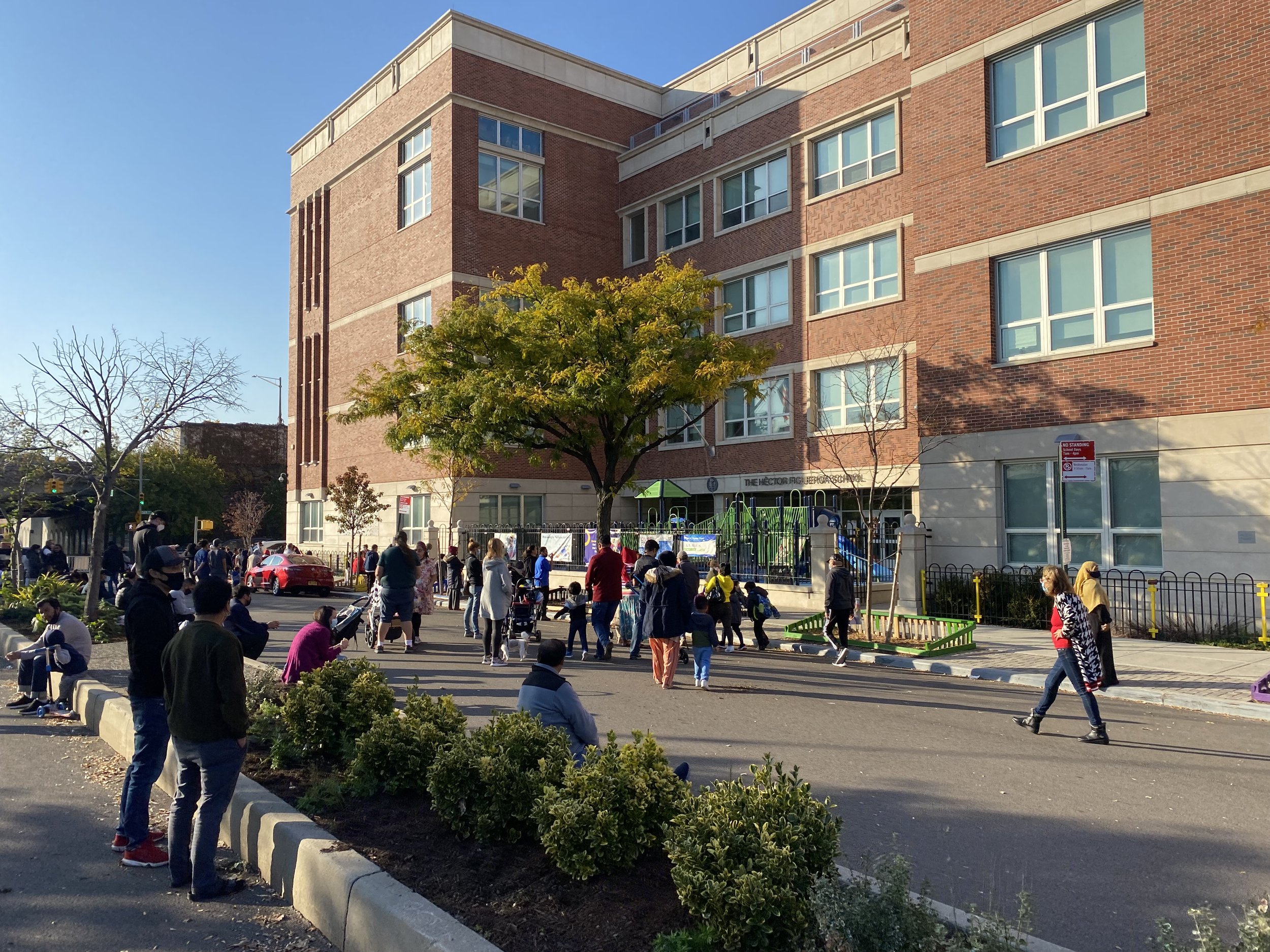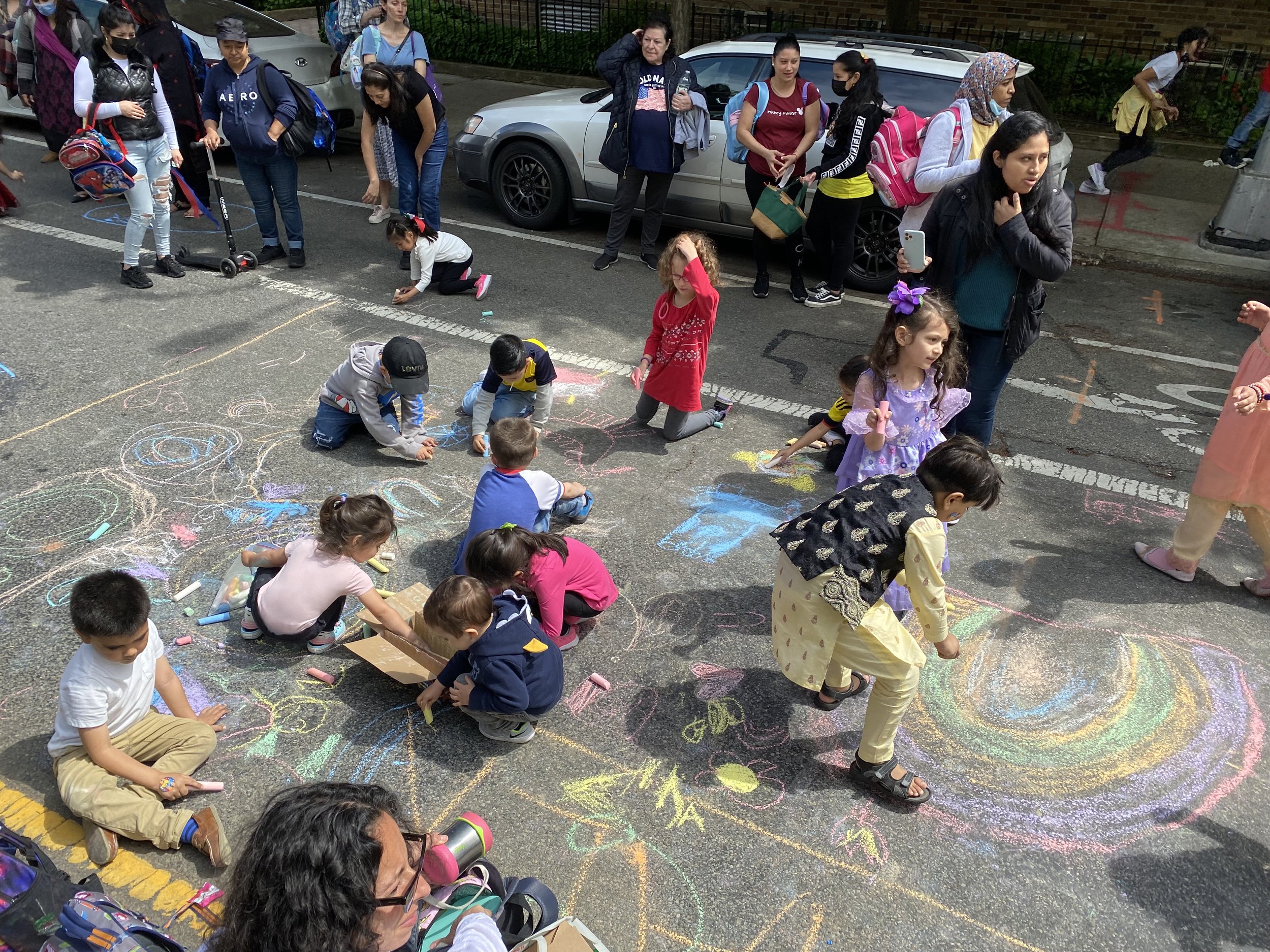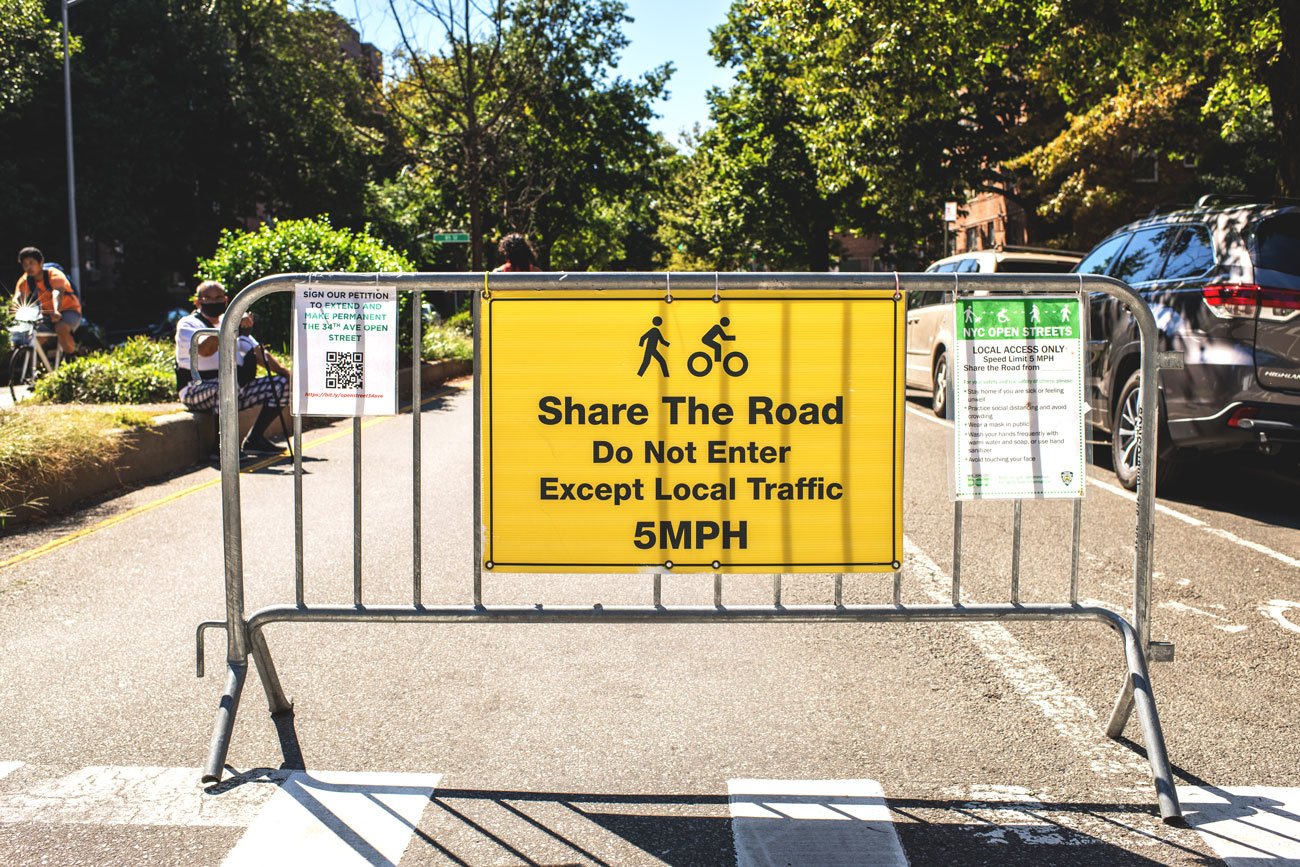
The NYC Department of Transportation’s Open Streets program turns car-centered streets into pedestrian-centered spaces by closing off the street from cars and traffic. Open Streets for Schools are Open Streets that are run, maintained, and programmed by nearby Pre-K, K-12, or higher education schools. They reimagine a roadway not dominated by cars but built for children to play, learn, and thrive.
What are the benefits of an Open Street for Schools?
Less car traffic, increasing safety, and reducing the risk of crashes
Space for outdoor learning and recess
Calmer arrival and dismissal times
Space for community meetings, after-school programming, support services, outdoor fairs, and festivals
Improved air quality, reducing the risk of childhood lung conditions, chronic illness, and asthma
Increased independence and more children walking and cycling to school
Easy Access-a-Ride use
Fewer children being driven to school





Ready to take the first step?
Download the School Streets Toolkit
What is this Toolkit?
Does your school seek traffic safety during arrival and dismissal? More space to play? Do you want to have music, science experiments, or silliness outdoors?
Congratulations! You have taken the first step towards making your school community a safer and more energetic space. This kit is designed to simplify the process of applying for a school street (and hopefully be fun along the way!). Within this resource, you will learn exactly how to submit an application, how to engage with and organize fellow community members, and how we at Open Plans and Transportation Alternatives can assist you in using this information to make real, tangible change at and around your school.
This toolkit is a practical guide created to assist school administrators and community residents develop school streets in their communities. We have compiled the expertise and experiences of administrators, transportation professionals, teachers, students, parents, organizers, and the wider school community. This is your step-by-step guide to implementing, programming, and maintaining a school street.
How to Get a School Street
Step 1:
Determining Location & Usage
Determining Location
There may be more than one street adjacent to your school that could be designated as your Open Street. It is important to consider traffic impacts, daily routines, and accessibility when you are considering the potential location of a school street. In your application, DOT will want to know that you understand these issues and have chosen the best possible location for your Open Street. Also, while it is good practice to have a preliminary idea of the proposed Open Street prior to speaking to community members, you may find that feedback influences the final location and operational hours.
-
Consider which streets adjacent to your school are traffic-sensitive or on MTA bus routes. Closing these roads, which carry higher volumes of traffic, is more complex than a less traffic-burdened street.
-
Consider where traffic safety data shows a greater number of traffic injuries or deaths within 500 feet of the school grounds over the last five years. This could provide clear evidence of an existing traffic safety problem.
Data provided upon request - contact research@transalt.org
-
Consider where there are high air pollution levels outside of schools (high levels of traffic or manufacturing). This could get stakeholders invested in the public health benefits of an Open Street for the school.
-
You want the use of the Open Street to be incorporated into your school routine. Placing it on the street used for arrival and dismissal may help keep students safe from traffic crashes and encourage families to engage with the school community.
Determining Usage
After you’ve talked to your school community, make sure to have conversations with your internal school community, too — teachers, administrators, paraprofessionals, and more — to determine how to use your school street. The most successful school streets have experimented with different types of usage.
-
Many schools use their school street to ease arrival and dismissal by closing off the street from cars during those hours. This strategy is:
• Low maintenance: requires no additional staff, programming planning, or physical materials.
• Modifiable: some schools allow school buses to pass through the school street at the end of the day or permit some teacher parking
• Safe: reduces car fatalities and injuries
• Social: allows for safe socialization between parents and teachers at arrival.
-
School streets do not just need to belong to individual schools but can benefit the entire community. Many schools host programming such as:
• Voter Registration Clinics
• Mental Wellness Booths
• Street Vendors
-
On 34th Avenue in Jackson Heights, Queens, Open Streets organizers like the 34th Avenue Coalition, partner with the City and other community-based organizations to fund afterschool programming that starts at pick-up and extends deeper into the afternoon. Some successful programming, particularly for younger children, include Zumba, dance, aerobics, hula hooping, chalking, and other wellness activities.
-
Schools lacking a play yard or ample space for children to play might need additional space for recess and can set up cones and portable equipment for outdoor recess.
-
Many schools need additional space to navigate concerns of overcrowding and social distancing during COVID-19 spikes. During the early spikes of the COVID-19 pandemic, PS 146 in Brooklyn needed additional space to disperse class periods because of overcrowding; instead of releasing 600 kids and parents in a cafeteria, the open street allowed for more movement, freedom, space, and organization.
-
Some schools extend the classroom to the entire community; WHEELS School in Washington Heights hosts community educational programming around environmental justice; they use the open school street as a community science lab, hosting climate justice teach-ins with the community (and nearby university students and professors partner up to provide some technical assistance), allowing students to lead community members in workshops to collect water quality, tree coverage, and heat data to share with elected officials to advocate for more resources, support, and funding. Other schools host biking programs, where a principal teaches cycling to students who don’t have bikes or can’t ride.
Step 2:
Engaging Stakeholders
As of 2022, DOT requires all schools who are applying for an Open Street to obtain three letters of support from community stakeholders. A stakeholder is any individual, group, or organization that would be impacted by the implementation of a school street. One of the keys to success in developing an Open Street for your school is to consider a diverse range of potential stakeholders, both within and outside of your school.
Informative and ongoing communications with residents, parents, and school staff is essential. It bolsters your application but, most importantly, allows the school street to reflect the broad needs and input of the entire community using both community and school resources. You can communicate with stakeholders in various formats including letters, emails, social media, and videos. It is an important process at every project stage, from consultation to notification of events or changes.
Create a plan which dictates how (and who) will directly engage with community members and partner organizations as early as possible for each stage of your project. Share with partner organizations you may be working with.
Where possible, offer in-person engagement events to listen to and address concerns raised by local residents. Events should be scheduled at different times and days to accommodate as many people as possible.
Consider the local community and if any communications should be distributed in languages other than English.
Speak to any businesses directly impacted by a timed road closure face-to-face to help explain the benefits and address concerns.
Be mindful of common questions and concerns; Share an FAQ document at public-facing events. Share this document directly with key stakeholders.
Arrange meetings with neighboring business owners, religious institutions, afterschool programs, etc., to inform them directly about the School Street ahead of launching to answer any questions or concerns.
Janitorial Operations
Meet with your school custodial staff about their responsibilities for the trash removal on the proposed Open Street. Create and commit to a plan of action. Custodial staff should know exactly what times, and to what extent, they are required to clean up the street space. If this task will be delegated to teachers or other members of the school community, be sure to indicate this in your operations plan.
Step 3:
Mobilizing Community Members
What are different strategies that people can use to make community members excited about school streets? Energizing community members around school streets , from creating new organizers to finding parents to help with the application, building relationships with local media who can write stories about your school street, to navigating any community pushback.
-
Canvassing or tabling can be a good strategy to use for broader education around school streets. This can be used before applications are submitted to build support and once the school has already applied for a school street to let their neighbors know about this upcoming community amenity. You can print out flyers explaining what school streets are, or use our one-pager in the resource section of this toolkit! Make sure to have a quick pitch that you can share with community members explaining:
What a school street is
Why your neighborhood needs a school street
How they can get involved in the process
-
An administrator from Brooklyn Prospect International School shared that because they were collocated with another school, they were able to ease the application process. If your school is collocated, make sure you’re collaborating with other schools to make your application simpler, and shorter, and lessen the burden of staffing and administrative labor. Plus, you can build community between your schools in the process!
-
An administrator from Brooklyn Prospect International shared that during the application process, their local Council Member visited, and expressed support of their application to DOT application process. Support from local elected officials makes a difference. Reach out to Council Members and local representatives who may already have existing relationships with DOT. Local representatives can also use school visits to share information about the benefits of open streets for schools.
-
In order to build community with neighbors on their block, PS 34 sent letters to neighbors adjacent to the school street to tell them what to expect in the coming year. Send a letter to residents to help include them in the planning process and street coordination discussions.
-
Hosting temporary activations, such as programming for children, reading libraries, chalking, music, and dance, can show community members the benefits of an open street as a resource and provides you an opportunity to test out various programs.
-
Parents from PS 222 recommended starting by hosting multilingual town-halls for parents Snacks and coffee are always welcome.
Use this as an opportunity to build a case by talking to administrators, parents, and students in your neighborhoods who already have school streets and ask questions like, what do you love about this program? What resources do you need to make this program as useful to you as possible? What did you think about the application process? Do you have a story that you love about how your students used the open street?
This is also a good opportunity to solicit signatures for a petition or letter of interest.
Step 4:
Install and Manage
Once your application has been approved, you'll be responsible for maintaining and programming the space.
The success of a school street is dependent on reducing the number of motor vehicles entering the zone. In order to achieve this, there will need to be a deterrent to ensure drivers keep out.
Upon request, the DOT can provide metal barricades for school use. Schools will be responsible for placing and removing the barricades daily. You will communicate this process in the “Operation Plan” component of the application.
If your school houses an afterschool program not staffed by school teachers, speak with them about potentially expanding the hours of afterschool staff (with compensation) to assist in the management of the School Street.
Programming
NYC Dot’s Public Space Programming initiative brings a wide variety of activities and events to public spaces, such as plazas, Open Streets, and other DOT-owned public spaces.
Programming brings arts, culture, fitness, educational experiences, and more to neighborhoods in need. Providing programming to Priority Investment Areas, as identified in the NY StreetsPlan, encourages the positive use of public space, and supports community outreach efforts.
Contact information for each organization is listed in the programming guide along with their offerings, please feel free to reach out to them to discuss this in more detail. As you book programming partners, please let DOT know where and when you will be engaging these organizations by contacting programming@dot.nyc.gov.
Additional Resources
Traffic Monitoring Tools
Sample Open Street Site Plan
Management, Staffing, and Outreach Plans
School Street Myths (and Realities)
Sample Canvassing Pitch
Sample Letter Template
Tips for Contacting Legislators
We’re here to help!
If you have questions about Open Streets for Schools or the application process, get in touch at schoolstreets [at] openplans.org
Looking to send an Open Streets Program Application? Click here.
D’Shandi Coombs
Schools Organizer
Transportation Alternatives
dshandi.coombs@transalt.org
Sabina Unni
School Streets Organizer
Open Plans
sabina@openplans.org





